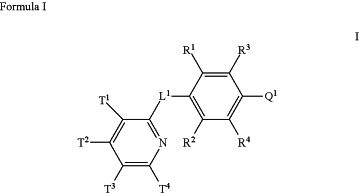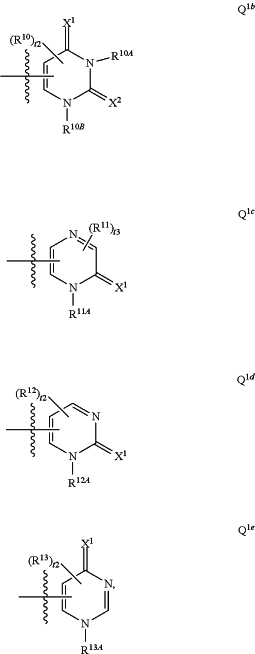| CPC C07D 401/14 (2013.01) [A61K 31/444 (2013.01); A61K 31/501 (2013.01); A61K 31/506 (2013.01); A61K 31/513 (2013.01); A61P 25/18 (2018.01); A61P 25/28 (2018.01); C07D 401/12 (2013.01); C07D 403/12 (2013.01); C07D 405/14 (2013.01)] | 20 Claims |
|
1. A method for treating a D1-associated disorder in a human, comprising administering to the human a therapeutically effective amount of a compound of
 or a pharmaceutically acceptable salt thereof, wherein:
each of T1, T2, T3, and T4 is independently selected from the group consisting of H, halogen, —CN, —SF5, —OH, —N(Ra)(Rb), —C(═O)—N(Ra)(Rb), —C(═O)—ORc, —C(═O)—Rd, C1-6 alkyl, C1-6 haloalkyl, C2-6 alkenyl, C2-6 alkynyl, C1-6 alkoxy, C1-6 haloalkoxy, —S—(C1-6 alkyl), C3-7 cycloalkyl, 4- to 7-membered heterocycloalkyl, C3-7 cycloalkoxy, 5- or 6-membered heteroaryl, cyclopropylmethyl, and cyclobutylmethyl, wherein each of the C1-6 alkyl, C2-6 alkenyl, C2-6 alkynyl, —S—(C1-6 alkyl), and C1-6 alkoxy is optionally substituted with one or more substituents each independently selected from the group consisting of halogen, —OH, —CN, —N(Ra)(Rb), C1-4 alkoxy, C1-4 haloalkoxy, and —S—(C1-4 alkyl); and wherein each of the C3-7 cycloalkyl, 4- to 7-membered heterocycloalkyl, C3-7 cycloalkoxy, 5- or 6-membered heteroaryl, cyclopropylmethyl, and cyclobutylmethyl of T1, T2, and T3 is optionally substituted with one or more substituents each independently selected from the group consisting of halogen, —OH, —CN, oxo, —N(Ra)(Rb), —C(═O)OH, —C(═O)—C1-4 alkyl, —C(═O)—O—C1-4 alkyl, —C(═O)—N(Ra)(Rb), C1-4 alkyl, C1-4 haloalkyl, C1-4 hydroxylalkyl, C1-4 cyanoalkyl, C1-4 alkoxy, C1-4 haloalkoxy, and —S—(C1-4 alkyl);
L1 is selected from the group consisting of O, S, NH, N(C1-4 alkyl), N(—C1-2 alkyl-C3-4 cycloalkyl), and N(C3-6 cycloalkyl);
each of Ra and Rb is independently selected from the group consisting of H, C1-4 alkyl, C3-7 cycloalkyl, and cyclopropylmethyl;
or Ra and Rb, together with the N atom to which they are attached, form 4- to 7-membered heterocycloalkyl optionally substituted with one or more substituents each independently selected from the group consisting of halogen, —OH, —CN, oxo, —NH2, —NH(C1-4 alkyl), —N(C1-4 alkyl)2, —C(═O)OH, —C(═O)—C1-4 alkyl, —C(═O)—O—C1-4 alkyl, —C(═O)—NH2, —C(═O)—NH(C1-4 alkyl), —C(═O)—N(C1-4 alkyl)2, C1-4 alkyl, C1-4 haloalkyl, C1-4 hydroxylalkyl, C1-4 cyanoalkyl, C1-4 alkoxy, —S—(C1-4 alkyl), and C1-4 haloalkoxy;
each of Rc and Rd is independently C1-4 alkyl, C3-4 cycloalkyl-C1-2 alkyl-, or C3-4 cycloalkyl;
Q1 is selected from the group consisting of Q1b, Q1c, Q1d and Q1e:
 provided (a) that a ring carbon atom of the Q1 ring is attached to the benzene ring of Formula I and (b) that when L1 is NH, then the Q1 ring is substituted with at least one non-H R10, R11, R12, R13, R10A, R10B, R11A, R12A, or R13A;
each of X1 and X2 is independently O or S;
each of R1, R2, R3, and R4 is independently selected from the group consisting of H, halogen, —OH, —NO2, —CN, —SF5, C1-6 alkyl, C1-6 haloalkyl, C1-6 haloalkoxy, C2-6 alkenyl, C2-6 alkynyl, C3-7 cycloalkyl, a 4- to 10-membered heterocycloalkyl, —N(R5)(R6), —N(R7)(C(═O)R8), —C(═O)—N(R5)(R6), —C(═O)—R8, —C(═O)—OR8, —N(R7)(S(═O)2R8), —S(═O)2—N(R5)(R6), —SR8, and —OR8, wherein each of the C1-6 alkyl, C3-7 cycloalkyl, and heterocycloalkyl is optionally substituted with 1, 2, or 3 substituents each independently selected from the group consisting of halogen, —CN, oxo, —OH, C1-4 alkyl, C1-4 alkoxy, C1-4 haloalkyl, C1-4 haloalkoxy, C3-6 cycloalkyl, —N(R5)(R6), —N(R7)(C(═O)R8), —C(═O)—OR8, —C(═O)H, —C(═O)R8, —C(═O)N(R5)(R6), —N(R7)(S(═O)2R8), —S(═O)2—N(R5)(R6), —SR8, and —OR8;
or R2 and R4, together with the two carbon atoms to which they are attached, form a fused 5- or 6-membered heteroaryl, a fused 5- or 6-membered heterocycloalkyl ring, a fused 5- or 6-membered cycloalkyl ring, or a fused benzene ring, wherein each of the fused rings is optionally substituted with 1, 2, or 3 substituents each independently selected from the group consisting of halo, —CN, —OH, C1-4 alkyl, C1-4 alkoxy, C1-4 haloalkyl, and C1-4 haloalkoxy, and wherein the fused heterocycloalkyl ring or fused cycloalkyl ring is further optionally substituted with 1, 2, or 3 oxo;
R5 is H, C1-4 alkyl, C1-4 haloalkyl, or C3-7 cycloalkyl;
R6 is H or selected from the group consisting of C1-4 alkyl, C1-4 haloalkyl, C3-7 cycloalkyl, a 4- to 10-membered heterocycloalkyl, C6-10 aryl, a 5- to 10-membered heteroaryl, (C3-7 cycloalkyl)-C1-4 alkyl-, (4- to 10-membered heterocycloalkyl)-C1-4 alkyl-, (C6-10 aryl)-C1-4 alkyl-, and (5- to 10-membered heteroaryl)-C1-4 alkyl-, wherein each of the selections from the group is optionally substituted with 1, 2, 3, or 4 substituents each independently selected from the group consisting of —OH, —CN, C1-4 alkyl, C3-7 cycloalkyl, C1-4 hydroxylalkyl, —S—C1-4 alkyl, —C(═O)H, —C(═O)—C1-4 alkyl, —C(═O)—O—C1-4 alkyl, —C(═O)—NH2, —C(═O)—N(C1-4 alkyl)2, C1-4 haloalkyl, C1-4 alkoxy, and C1-4 haloalkoxy;
or R5 and R6, together with the N atom to which they are attached, form a 4- to 10-membered heterocycloalkyl or a 5- to 10-membered heteroaryl, each optionally substituted with 1, 2, 3, 4, or 5 substituents each independently selected from the group consisting of halogen, —OH, oxo, —C(═O)H, —C(═O)—C1-4 alkyl, —C(═O)OH, —C(═O)—O—C1-4 alkyl, —C(═O)—NH2, —C(═O)—N(C1-4 alkyl)2, —CN, C1-4 alkyl, C1-4 alkoxy, C1-4 hydroxylalkyl, C1-4 haloalkyl, and C1-4 haloalkoxy;
R7 is selected from the group consisting of H, C1-4 alkyl, and C3-7 cycloalkyl;
R8 is selected from the group consisting of C1-6 alkyl, C3-7 cycloalkyl, a 4- to 10-membered heterocycloalkyl, C6-10 aryl, a 5- to 10-membered heteroaryl, (C3-7 cycloalkyl)-C1-4 alkyl-, (4- to 10-membered heterocycloalkyl)-C1-4 alkyl-, (C6-10 aryl)-C1-4 alkyl-, and (5- to 10-membered heteroaryl)-C1-4 alkyl-, wherein each of the selections from the group is optionally substituted with 1, 2, or 3 substituents each independently selected from the group consisting of halogen, —CF3, —CN, —OH, oxo, —S—C1-4 alkyl, C1-4 alkyl, C1-4 haloalkyl, C2-6 alkenyl, C2-6 alkynyl, C3-7 cycloalkyl, C1-4 alkoxy, and C1-4 haloalkoxy;
each R12 is independently selected from the group consisting of halogen, —OH, —CN, —SF5, —NO2, C1-6 alkyl, C1-6 haloalkyl, C1-6 hydroxylalkyl, C1-6 alkoxy, C1-6 haloalkoxy, C3-7 cycloalkyl, C2-6 alkenyl, C2-6 alkynyl, a 4- to 10-membered heterocycloalkyl, a 5- to 10-membered heteroaryl, (C3-7 cycloalkyl)-C1-4 alkyl-, (4- to 10-membered heterocycloalkyl)-C1-4 alkyl-, (C6-10 aryl)-C1-4 alkyl-, (5- to 10-membered heteroaryl)-C1-4 alkyl-, —N(R5)(R6), —N(R7)(C(═O)R8), —S(═O)2N(R5)(R6), —C(═O)—N(R5)(R6), —C(═O)—R8, —C(═O)—OR8, —SR8, and —OR8, wherein each of the C1-6 alkyl, C3-7 cycloalkyl, 4- to 10-membered heterocycloalkyl, 5- to 10-membered heteroaryl, (C3-7 cycloalkyl)-C1-4 alkyl-, (4- to 10-membered heterocycloalkyl)-C1-4 alkyl-, (C6-10 aryl)-C1-4 alkyl-, and (5- to 10-membered heteroaryl)-C1-4 alkyl- is optionally substituted with 1, 2, 3, or 4 substituents each independently selected from the group consisting of halogen, —OH, —CN, —NO2, C1-4 alkyl, C1-4 hydroxylalkyl, C1-4 alkoxy, —N(R5)(R6), —S—(C1-4 alkyl), —S(═O)2—(C1-4 alkyl), C6-10 aryloxy, [(C6-10 aryl)-C1-4 alkyloxy- optionally substituted with 1 or 2 C1-4 alkyl], oxo, —C(═O)H, —C(═O)—C1-4 alkyl, —C(═O)O—C1-4 alkyl, —C(═O)NH2, —NHC(═O)H, —NHC(═O)—(C1-4 alkyl), C3-7 cycloalkyl, a 5- or 6-membered heteroaryl, C1-4 haloalkyl, and C1-4 haloalkoxy;
each of R10, R11 and R13 is independently selected from the group consisting of halogen, —OH, —CN, —SF5, —NO2, C1-6 alkyl, C1-6 haloalkyl, C1-6 hydroxylalkyl, C1-6 alkoxy, C1-6 haloalkoxy, C3-7 cycloalkyl, C2-6 alkenyl, C2-6 alkynyl, C6-10 aryl, a 4- to 10-membered heterocycloalkyl, a 5- to 10-membered heteroaryl, (C3-7 cycloalkyl)-C1-4 alkyl-, (4- to 10-membered heterocycloalkyl)-C1-4 alkyl-, (C6-10 aryl)-C1-4 alkyl-, (5- to 10-membered heteroaryl)-C1-4 alkyl-, —N(R5)(R6), —N(R7)(C(═O)R8), —S(═O)2N(R5)(R6), —C(═O)—N(R5)(R6), —C(═O)—R8, —C(═O)—OR8, —SR8, and —OR8, wherein each of the C1-6 alkyl, C3-7 cycloalkyl, C6-10 aryl, 4- to 10-membered heterocycloalkyl, 5- to 10-membered heteroaryl, (C3-7 cycloalkyl)-C1-4 alkyl-, (4- to 10-membered heterocycloalkyl)-C1-4 alkyl-, (C6-10 aryl)-C1-4 alkyl-, and (5- to 10-membered heteroaryl)-C1-4 alkyl- is optionally substituted with 1, 2, 3, or 4 substituents each independently selected from the group consisting of halogen, —OH, —CN, —NO2, C1-4 alkyl, C1-4 hydroxylalkyl, C1-4 alkoxy, —N(R5)(R6), —S—(C1-4 alkyl), —S(═O)2—(C1-4 alkyl), C6-10 aryloxy, [(C6-10 aryl)-C1-4 alkyloxy- optionally substituted with 1 or 2 C1-4 alkyl], oxo, —C(═O)H, —C(═O)—C1-4 alkyl, —C(═O)O—C1-4 alkyl, —C(═O)NH2, —NHC(═O)H, —NHC(═O)—(C1-4 alkyl), C3-7 cycloalkyl, a 5- or 6-membered heteroaryl, C1-4 haloalkyl, and C1-4 haloalkoxy;
R10A is selected from the group consisting of H, C1-6 alkyl, C1-6 hydroxylalkyl, C2-6 alkenyl, —S(═O)2N(R5)(R6), —C(═O)—N(R5)(R6), —C(═O)—R8, —C(═O)—OR8, —SR15, —C(R14)2—OH, —C(R14)2—OS(═O)2H, —C(R14)2—OP(═O)(OH)2, —C(R14)2—OR15, —C(R14)2—OC(═O)—R15, and —C(R14)2—N(R5)(R6);
each of R10B, R11A, R12A, and R13A is independently selected from the group consisting of H, C1-6 alkyl, C1-6 haloalkyl, C1-6 hydroxylalkyl, C3-7 cycloalkyl, C3-6 alkenyl, C3-6 alkynyl, C6-10 aryl, a 4- to 10-membered heterocycloalkyl, a 5- to 10-membered heteroaryl, (C3-7 cycloalkyl)-C1-4 alkyl-, (4- to 10-membered heterocycloalkyl)-C1-4 alkyl-, (C6-10 aryl)-C1-4 alkyl-, (5- to 10-membered heteroaryl)-C1-4 alkyl-, —S(═O)2N(R5)(R6), —C(═O)—N(R5)(R6), —C(═O)—R8, and —C(═O)—OR8, wherein each of the C1-6 alkyl, C3-7 cycloalkyl, C6-10 aryl, 4- to 10-membered heterocycloalkyl, 5- to 10-membered heteroaryl, (C3-7 cycloalkyl)-C1-4 alkyl-, (4- to 10-membered heterocycloalkyl)-C1-4 alkyl-, (C6-10 aryl)-C1-4 alkyl-, and (5- to 10-membered heteroaryl)-C1-4 alkyl-, is optionally substituted with 1, 2, 3, or 4 substituents each independently selected from the group consisting of halogen, —OH, —CN, —NO2, C1-4 alkyl, C1-4 hydroxylalkyl, C1-4 alkoxy, —N(R5)(R6), —S—(C1-4 alkyl), —S(═O)2—(C1-4 alkyl), C6-10 aryloxy, [(C6-10 aryl)-C1-4 alkyloxy- optionally substituted with 1 or 2 C1-4 alkyl], oxo, —C(═O)H, —C(═O)—C1-4 alkyl, —C(═O)O—C1-4 alkyl, —C(═O)NH2, —NHC(═O)H, —NHC(═O)—(C1-4 alkyl), —OC(═O)—C1-4 alkyl, C3-7 cycloalkyl, a 5- or 6-membered heteroaryl, C1-4 haloalkyl, and C1-4 haloalkoxy;
each R14 is independently H or selected from the group consisting of C1-10 alkyl, C3-14 cycloalkyl, C2-10 alkenyl, C2-10 alkynyl, C6-10 aryl, 4- to 10-membered heterocycloalkyl, 5- to 10-membered heteroaryl, (C3-14 cycloalkyl)-C1-10 alkyl-, (4- to 14-membered heterocycloalkyl)-C1-10 alkyl-, (C6-10 aryl)-C1-10 alkyl-, (5- to 10-membered heteroaryl)-C1-10 alkyl-, wherein each of the selections of the group is optionally substituted with 1, 2, 3, or 4 substituents each independently selected from the group consisting of halogen, —OH, —CN, —NO2, C1-4 alkyl, C1-4 hydroxylalkyl, C1-4 alkoxy, —N(R5)(R6), —N(R7)C(═O)R8, —N(R7)C(═O)OR8, —N(R7)S(═O)2R8, —S(═O)2N(R5)(R6), —C(═O)—N(R5)(R6), —C(═O)—R8, —C(═O)—OR8, —SR8, —OR8, —S(═O)2—R8, C6-10 aryloxy, [(C6-10 aryl)-C1-4 alkyloxy- optionally substituted with 1 or 2 C1-4 alkyl], oxo, —C(═O)H, —NHC(═O)H, C3-7 cycloalkyl, a 5- or 6-membered heteroaryl, C1-4 haloalkyl, and C1-4 haloalkoxy;
R15 is selected from the group consisting of C1-20 alkyl, C3-14 cycloalkyl, C2-20 alkenyl, C2-20 alkynyl, C6-10 aryl, 4- to 14-membered heterocycloalkyl, 5- to 10-membered heteroaryl, (C3-14 cycloalkyl)-C1-20 alkyl-, (4- to 10-membered heterocycloalkyl)-C1-20 alkyl-, (C6-10 aryl)-C1-20 alkyl-, (5- to 10-membered heteroaryl)-C1-20 alkyl-, wherein each of the selections of the group is optionally substituted with 1, 2, 3, or 4 substituents each independently selected from the group consisting of halogen, —OH, —CN, —NO2, C1-4 alkyl, C1-4 hydroxylalkyl, C1-4 alkoxy, —N(R5)(R6), —N(R7)C(═O)R8, —N(R7)C(═O)OR8, —N(R7)S(═O)2R8, —S(═O)2N(R5)(R6), —C(═O)—N(R5)(R6), —C(═O)—R8, —C(═O)—OR8, —SR8, —OR8, —S(═O)2—R8, C6-10 aryloxy, [(C6-10 aryl)-C1-4 alkyloxy-optionally substituted with 1 or 2 C1-4 alkyl], oxo, —C(═O)H, —NHC(═O)H, C3-7 cycloalkyl, a 5- or 6-membered heteroaryl, C1-4 haloalkyl, and C1-4 haloalkoxy;
t1 is 0, 1, or 2;
t2 is 0 or 1; and
t3 is 0, 1, or 2, and
wherein the D1-associated disorder is substance abuse, drug dependence, or drug abuse relapse.
|